Create pillar content and grow your audience

Ready to create a killer piece of content for your business, but feeling spooked when it comes to all the little steps there are to complete?
“Pillar content” – long-form content that lives on your website forever, shows off your expertise, and ranks well in search results – can take time and resources to create.
When you reach the finish, however, you’ll love the feeling of having pillar content that informs your audience and sells you on your behalf.
If you like the idea of having a marketing asset that will
- Stand the test of time and serve your business over and over again,
- Assert credibility and deep expertise, and
- Help guide new prospects toward working with you,
Read on.
Also, to help with your pillar content process, I’ve created a “pillar content toolkit” of 5 FREE resources to help speed the process along, including a PDF copy of this entire guide. Cement what you learn and grab the toolkit here.
(Or grab it by clicking this link)
Before you create pillar content, make an “outstanding outline”
By now, we’ve identified the value of pillar content and also done some work to figure out what topic you should write about.
We’re not going to write a single word of your post yet, though…
Instead, we’re going to make your life 50 times easier by creating what I like to call your “outstanding outline”.
When you’ve created a clear, detailed outline, the writing part becomes so much easier, because you can just open your computer each day, look at your outline, and begin spilling knowledge on whatever headline or subheadline you need to make progress on.
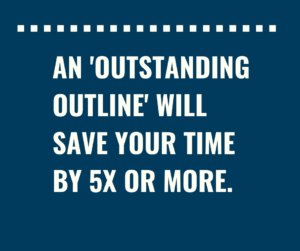
Pillar content ends up taking one of two forms. Either
- You produce a single sprawling post that has multiple headlines and “chapters” or subheadlines within it, or
- You produce multiple posts that are designed to go together (also “chapters”, but each chapter being its own standalone blog).
- The advantage to this approach is that each post can have a separate keyword focus, which can spread your net wider.
Either way, I propose you think of your pillar content as chunks or “chapters” that you’re going to sew together.
You want to outline as many of your headlines and subheadlines as possible. For example, the outline of the previous post in this guide, which came out to about 1,800 words, was as follows:
Part 2: Content Ideas: Figure out what content to create
- Introduction
- Content Upgrade
- 4-Step Process
- Step 1: How to get ideas out of your head
- Freewriting
- Mindstorming
- Taking notes
- How to source ideas from your audience
- Why this is valuable
- Questions to ask
- Step 2: Define your content objective
- The methodology approach
- Thee discovery approach
- Step 3: How to research keywords
- Definition of traffic
- Types of keywords
- Search frequency and search results
- Where to start
- Step 4: How to research competition
- When to make it better
- When to make it different
- Conclusion
Each item I outlined was a headline or subheadline of some kind, which gave me a roadmap for easily writing the article.
The more detailed your outline, the easier your writing; you’ll discover over time how much outlining works best for you.
Your content does not have to be set in stone after the outline is complete.
In fact, sections are usually rearranged, added, or removed once you begin the writing process, because you’ll discover that some sections are not necessary and others are massively important.
By creating a tight outline, you’ll create structure for the writing process that is easy to execute.

How to write your pillar content
Pillar content creation can be a daunting task, but look at it this way: once you have written it and published it, the work is done and you’ll be able to refer back to it again and again.
If you’re rusty on writing, it may take some time to find your rhythm.
Start by blocking off times in your calendar in which you want to write, and focus on producing a certain number of words in that block of time. I like to write in Google Docs and use the ‘word count’ tool when I begin and when I end so I know what I have written.
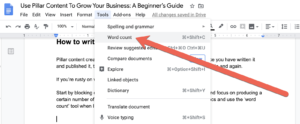
This can give you some structure and help you set small goals for how much you want to write.
Do not worry about editing what you’re writing at this time. In this first pass, we actually want to get the words down on the page as quickly as we can and not obsess too much on voice, tone, or language.
Write for speed. For topics where you really know your stuff, it’s not unusual to kick out 1,000, 1,500, or even 2,000 words in an hour’s time.
Let the words flow; we’ll come back and do editing passes later on.
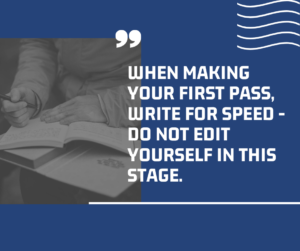
Use Examples
One of the easiest ways to create variety in your writing and back up your points is to use examples.
But you don’t want to disrupt your flow and spend half an hour trying to track down that perfect client example or demonstration of your work on the internet. You’ll lose your writing flow.
So instead, I suggest you type the word “PLACEHOLDER” or “EXAMPLE” in your document, and come back to it later in another draft.
I like to put multiple brackets on mine so that they are easier to find when I’m scanning back through my doc; the placeholder looks like this:
<<<PLACEHOLDER>>>
This can make your later drafts easier and more time-efficient.
Think optically
Our eyes fatigue when reading large blocks of text, especially on screens.
That’s why it might be beneficial for you to break up blocks of text into paragraphs that are just a sentence or two, and incorporate images every few paragraphs.
Social Media Examiner, a top site for social media how-to content, has in their contributor guidelines instructions to supply an image or screenshot every 5-6 paragraphs to help the reader better understand the article.
Here’s an article I’ve written for them before where you can see these spacing instructions in action.
Even if you write an absolute masterpiece, many of the people who come across your pillar content will skim on the first pass, and that’s perfectly alright.
Make it easy for them to understand what you’re communicating about even if they are just passing through.

How to ensure your pillar content generates leads
If users consume our pillar content and are engaged, we want to take the next step and ask them to join our audience.
I recommend one of your audiences be an email list, as email is less at the mercy of algorithm changes and feeds when it comes to communicating future updates with your audience.
In email marketing, we often use what is called an “opt-in bribe” or a “lead magnet”.
This opt-in bribe is an ethical bribe in which we offer something – a discount, a free report, a checklist – in exchange for someone’s email address.
“Bribe” can feel like a dirty word. But you have already interacted with opt-in bribes many times without realizing you have been bribed.
Here’s a bribe that popped up from T-shirt company Threadless: “Join our email list and get a coupon for 25% off.”
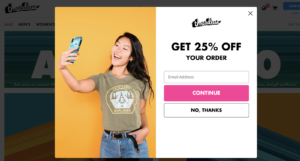
Here’s another example from nutrition consulting company Renaissance Periodization: “Get 4 eBooks we normally charge for for free when you join our email list.”
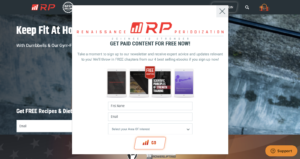
You’ll probably start to see opt-in bribes all over the internet now that you have an eye for them.
That’s because they work!
There’s a reason why the saying “the money is in the list” has held up for years even as social media platforms come and go; email gets a great return on investment.
One of the best opt-in bribes you can do is called a “content upgrade”.
This bribe is specific to the content that someone is consuming; it’s something that will make the user’s application of this content easier, faster, or both.
In this guide, for example, my opt-in bribe is a toolkit of tools and checklists that help you execute on the information found in this guide faster.
I bundled these small tools together and offer the same content upgrade on each page of the guide to make the back-end a little easier.
I’ll shamelessly put the opt-in bribe here again for convenience.
Your content upgrade doesn’t have to be fancy; it can just be a copy of your content in PDF format, almost like an ebook.
This makes it easier for readers to reference back to your material even when they don’t have internet access.
Build in opt-in bribe into your pillar content strategy and you’ll see users begin signing up for your list to hear more from you.
—
I go into more detail on some other optional upgrades to your pillar content in part 6 of this guide. For now though, just get writing!
Up next, we’ll discuss how to plan out and execute the release of your pillar content in a way that captures valuable attention and interest.

